A slasher film is a subgenre of horror films involving a killer or a group of killers stalking and murdering a group of people, usually by use of bladed or sharp tools. Although the term "slasher" may occasionally be used informally as a generic term for any horror film involving murder, film analysts cite an established set of characteristics which set slasher films apart from other horror subgenres, such as monster movies, splatter films, supernatural and psychological horror films.
Dimension Films is an American inactive independent film and television production and distribution company owned by Lantern Entertainment. It was formerly used as Harvey and Bob Weinstein's label within Miramax, which was acquired by The Walt Disney Company on June 30, 1993, and it later became a part of The Weinstein Company (TWC) from 2005 until 2018. The company produces and releases independent films and genre titles, specifically horror and science fiction films.
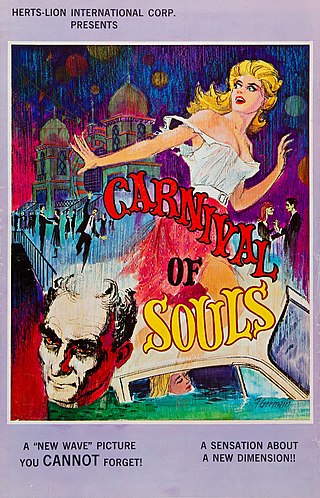
Carnival of Souls is a 1962 American psychological horror film produced and directed by Herk Harvey and written by John Clifford from a story by Clifford and Harvey, and starring Candace Hilligoss. Its plot follows Mary Henry, a young woman whose life is disturbed after a car accident. She relocates to a new city, where she finds herself unable to assimilate with the locals, and becomes drawn to the pavilion of an abandoned carnival. Director Harvey also appears in the film as a ghoulish stranger who stalks her throughout. The film is set to an organ score by Gene Moore.
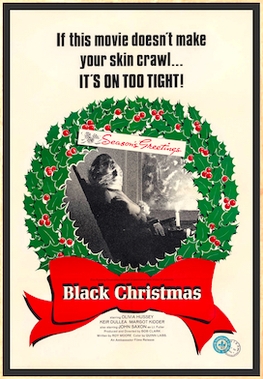
Black Christmas is a 1974 Canadian slasher film produced and directed by Bob Clark, and written by Roy Moore. It stars Olivia Hussey, Keir Dullea, Margot Kidder, and John Saxon. The story follows a group of sorority sisters who receive threatening phone calls and are eventually stalked and murdered by a mentally ill killer during the Christmas season.

Silent Night, Deadly Night is a 1984 American slasher film directed by Charles E. Sellier, Jr., and starring Robert Brian Wilson, Lilyan Chauvin, Gilmer McCormick, Toni Nero, Linnea Quigley, Britt Leach, and Leo Geter. The story concerns a young man named Billy, who suffers from post-traumatic stress over witnessing his parents' murder on Christmas Eve by a man disguised as Santa Claus and his subsequent upbringing in an abusive Catholic orphanage. In adulthood, the Christmas holiday leads him into a psychological breakdown, and he emerges as a spree killer donning a Santa suit.

Katherine Evelyn Anita Cassidy is an American actress. Following several minor television roles, she came to attention as a scream queen after starring in the horror films When a Stranger Calls (2006), as Kelli Presley in Black Christmas (2006) and as Ruby in the third season of the horror series Supernatural (2007–2008). Following a supporting role in the action film Taken (2008), Cassidy played leading roles in the slasher series Harper's Island (2009) and the remake of the drama series Melrose Place (2009–2010). She starred as Kris Fowles in the slasher film remake A Nightmare on Elm Street (2010) and had a recurring role as Juliet Sharp during the fourth season of the teen drama Gossip Girl (2010–2012).

Terror Train is a 1980 slasher film directed by Roger Spottiswoode — in his directorial debut — written by Thomas Y. Drake, and starring Jamie Lee Curtis, Ben Johnson, and Hart Bochner. The film follows a group of pre-medical school students holding a New Year's Eve costume party on a moving train who are targeted by a killer who dons their costumes. It features supporting performances from Sandee Currie, Anthony Sherwood, and David Copperfield.

The House on Sorority Row is a 1982 American slasher film written and directed by Mark Rosman, produced by John G. Clark, and starring Eileen Davidson and Kathryn McNeil. The plot follows a group of sorority sisters being stalked and murdered during their graduation party after they conceal a fatal prank against their house mother.
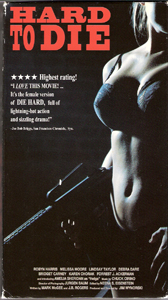
Sorority House Massacre III: Hard to Die is a 1990 American slasher film written by Mark Thomas McGee and James B. Rogers, directed by Jim Wynorski, and starring Gail Harris and Melissa Moore. The film features a similar storyline and many of the same actresses from its predecessor, and Wynorski's previous film Sorority House Massacre II, of which Hard to Die is essentially a remake.
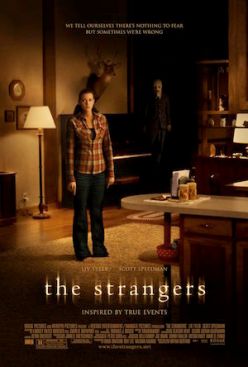
The Strangers is a 2008 American psychological horror film written and directed by Bryan Bertino. The film follows a couple whose stay at a vacation home is disrupted by three masked intruders who infiltrate the home one night. It is the first installment in The Strangers film series. The screenplay was inspired by two real-life events: the multiple-homicide Manson family Tate murders and a series of break-ins that occurred in Bertino's neighborhood as a child. Some journalists noted similarities between the film and the Keddie cabin murders that occurred in Keddie, California, in 1981, though Bertino did not cite this as a reference.

Kelli Presley is a fictional character in the 2006 slasher film Black Christmas. The character, created by writer-director Glen Morgan and portrayed by actress Katie Cassidy, serves as a replacement to Jess from the original film.

Silent Night is a 2012 slasher film directed by Steven C. Miller and starring Malcolm McDowell, Jaime King, Donal Logue, Ellen Wong, and Brendan Fehr. It is a remake of Charles E. Sellier Jr.'s 1984 film Silent Night, Deadly Night and the sixth installment in the Silent Night, Deadly Night film series. The film was given a limited theatrical release on November 30, 2012, and was released on DVD and Blu-ray Disc on December 4, 2012.

Silent Night, Deadly Night is an American Christmas horror film series, consisting of six films. The first film in the series, Silent Night, Deadly Night (1984), originally titled Slay Ride, tells the story of Billy, a young man who experiences a psychotic break and goes on a murder spree dressed as Santa Claus. The film received theatrical distribution from TriStar Pictures, but was pulled from theaters in November 1984 after a series of protests against the film.
The Massacre films are three interconnected series of slasher films executive-produced by Roger Corman: the Slumber Party Massacre series (1982–1990), the Sorority House Massacre series (1986–1990) and the Cheerleader Massacre series (2003–2011), distributed by New World Pictures and New Concorde. The series also features the standalone film Sharkansas Women's Prison Massacre (2015), and the reboot film Slumber Party Massacre (2021).

Billy is a fictional character from the Black Christmas film series, first appearing in Black Christmas (1974) as a deranged murderer who taunts and kills a group of college students during the Christmas season. Created by Bob Clark and A. Roy Moore, the character was partly inspired by the urban legend "The Babysitter and the Man Upstairs", as well as a series of real murders in Montreal during the 1943 holiday season.
Black Christmas is a Canadian-American horror film series that comprises three standalone slasher films, as well as a novelization. The original film has gained a large cult following and is credited as being one of the first slasher films, inspiring many others, including the critically acclaimed hit Halloween (1978). The series centers around a serial killer that stalks and murders a group of sorority sisters. The 1974 film follows the character of Jess Bradford as she and her sorority sisters begin receiving threatening phone calls from an unknown stalker. The 2006 film explores the background and motivation for the killer and his family. The 2019 film completely abandons the first two films' killer storyline, instead focusing on a new set of characters and killers.
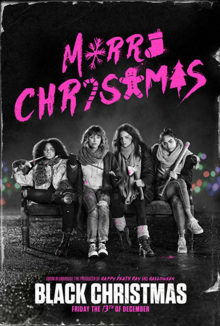
Black Christmas is a 2019 slasher film directed by Sophia Takal and written by Takal and April Wolfe. Part of the Black Christmas series, it is the loose second remake of the 1974 Canadian film of the same name, after the 2006 film and follows a group of sorority sisters at Hawthorne College as they are preyed upon by an unknown stalker. The film stars Imogen Poots, Aleyse Shannon, Lily Donoghue, Brittany O'Grady, Caleb Eberhardt and Cary Elwes.

Jess Bradford is a fictional character in the Black Christmas franchise. She is the main protagonist of Bob Clark's seminal slasher film Black Christmas (1974) in which she was portrayed by actress Olivia Hussey. Hussey, known internationally at the time for her role as Juliet in Romeo and Juliet (1968), signed on to the role after a psychic told her that she would be involved in a profitable Canadian film. Despite the dark undertones of the film and the mature themes, Hussey has described shooting the film as a great experience.
Chris Vander Kaay is a screenwriter and author primarily known for his work in the horror genre. He was the subject of the 2018 documentary Fear Man, exploring the sociological and psychological implications of horror fandom. With his wife Kathleen Fernandez-Vander Kaay he co-authored the 2018 book Indie Science Fiction Cinema Today: Conversations with 21st Century Filmmakers, about 21st century science fiction cinema. From 2016 to 2018, he was a contributing writer for Bloody Disgusting. With Chance Shirley he cofounded Subspace, a sci-fi movie curation service.

















